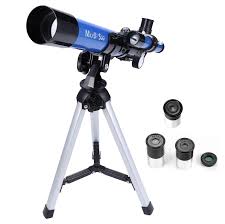Unveiling the Universe: The Marvels of Telescopes

Exploring the Universe with Telescopes
Telescopes have been instrumental in expanding our understanding of the cosmos. These powerful instruments allow us to peer into the depths of space, revealing distant galaxies, stars, and planets that are otherwise invisible to the naked eye.
One of the most famous telescopes in history is the Hubble Space Telescope. Launched into orbit in 1990, the Hubble has provided breathtaking images of celestial objects, revolutionizing our knowledge of the universe. Its observations have led to groundbreaking discoveries about the origins of galaxies, the existence of black holes, and the expansion of the universe.
Telescopes come in various types and sizes, each designed for specific purposes. Reflecting telescopes use mirrors to gather and focus light, while refracting telescopes use lenses. Some telescopes are ground-based observatories located on Earth, while others are placed in space to avoid atmospheric interference.
Amateur astronomers also benefit from telescopes, as they can explore the night sky from their own backyard. With modern advancements in technology, amateur telescopes have become more affordable and user-friendly, allowing enthusiasts to observe planets, nebulae, and other celestial objects with ease.
Whether gazing at distant galaxies or observing our own solar system, telescopes continue to inspire wonder and curiosity about the vastness of space. From professional astronomers to amateur stargazers, these incredible instruments play a crucial role in unlocking the mysteries of the universe.
5 Essential Tips for Choosing and Using Your Telescope Effectively
- Choose the right type of telescope for your needs and interests (e.g., refractor, reflector, or compound).
- Consider the aperture size of the telescope as it determines how much light it can gather for better viewing.
- Invest in quality eyepieces to enhance your viewing experience and achieve sharper images.
- Learn how to properly collimate your telescope to ensure optimal performance and clear images.
- Take your time to familiarize yourself with the telescope’s controls and practice using it before observing celestial objects.
Choose the right type of telescope for your needs and interests (e.g., refractor, reflector, or compound).
When selecting a telescope, it is essential to choose the right type that aligns with your specific needs and interests. Whether you are drawn to observing celestial objects like planets, stars, or deep-sky objects, understanding the differences between refractor, reflector, and compound telescopes can help you make an informed decision. Refractor telescopes use lenses to gather and focus light, providing crisp images of planets and the moon. Reflectors utilize mirrors to capture light, making them ideal for viewing faint deep-sky objects like galaxies and nebulae. Compound telescopes combine the best features of refractors and reflectors, offering versatility for various types of astronomical observations. By selecting the right type of telescope for your preferences, you can enhance your stargazing experience and delve deeper into the wonders of the universe.
Consider the aperture size of the telescope as it determines how much light it can gather for better viewing.
When selecting a telescope, it is important to consider the aperture size, as it directly influences the amount of light the telescope can gather for optimal viewing. A larger aperture allows more light to enter the telescope, resulting in brighter and clearer images of celestial objects. By choosing a telescope with a sufficient aperture size, astronomers and stargazers can enhance their viewing experience and observe distant stars, planets, and galaxies with greater detail and clarity.
Invest in quality eyepieces to enhance your viewing experience and achieve sharper images.
Investing in quality eyepieces is a crucial tip for enhancing your telescope viewing experience and achieving sharper images. The eyepiece is a key component that determines the clarity and detail of what you see through the telescope. By opting for high-quality eyepieces, you can improve the resolution, contrast, and overall image quality of celestial objects. Whether you are observing planets, stars, or deep-sky objects, investing in top-notch eyepieces will elevate your viewing sessions and allow you to appreciate the wonders of the universe with greater clarity and precision.
Learn how to properly collimate your telescope to ensure optimal performance and clear images.
Learning how to properly collimate your telescope is essential for ensuring optimal performance and clear images. Collimation refers to the alignment of the optical elements within a telescope, such as mirrors or lenses, to ensure that light is focused correctly. A well-collimated telescope will produce sharper images and better contrast, allowing you to fully appreciate the details of celestial objects. By mastering the collimation process, you can enhance your viewing experience and make the most of your telescope’s capabilities.
Take your time to familiarize yourself with the telescope’s controls and practice using it before observing celestial objects.
To make the most of your telescope viewing experience, it is essential to take your time to familiarize yourself with the telescope’s controls and practice using it before observing celestial objects. By becoming comfortable with how the telescope operates and adjusting its settings, you can ensure smoother and more enjoyable stargazing sessions. Practicing beforehand allows you to hone your skills in locating and focusing on celestial objects, ultimately enhancing your overall viewing experience.
